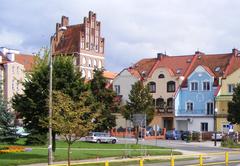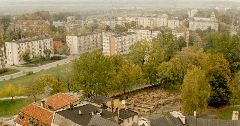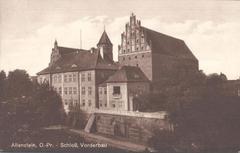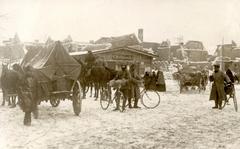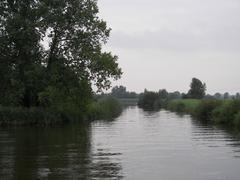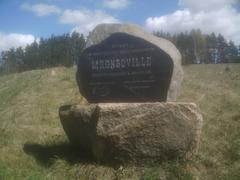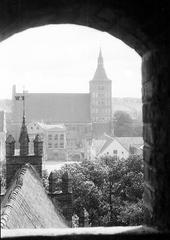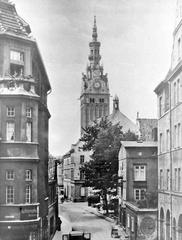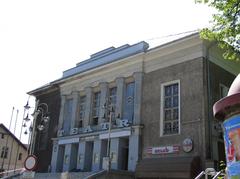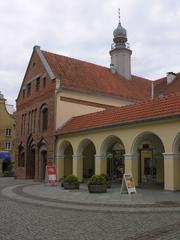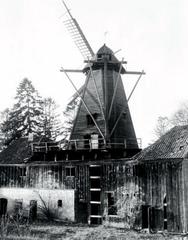
Dominican Church Elbląg: Visiting Hours, Tickets, History, and Travel Guide
Date: 04/07/2025
Introduction
The Dominican Church in Elbląg, situated in the heart of the city’s Old Town in the Warmian-Masurian Voivodeship of northern Poland, stands as a remarkable monument to centuries of religious, architectural, and cultural evolution. Established in the mid-13th century with the arrival of the Dominican Order, this Gothic edifice has witnessed pivotal events in Elbląg’s history—surviving the Teutonic Knights’ rule, the Hanseatic League era, the Reformation, and the devastation of World War II. Today, the church serves both as a symbol of resilience and as Galeria EL, a vibrant center for contemporary art, seamlessly blending medieval heritage with modern cultural life (Wikipedia: Elbląg; medievalheritage.eu).
This guide provides detailed information on the church’s history, architectural significance, visiting hours, ticketing, accessibility, and practical travel tips to help you make the most of your visit to one of Elbląg’s most iconic landmarks.
Table of Contents
- Historical Overview
- Cultural and Artistic Significance
- Visitor Information
- Travel Tips and Nearby Attractions
- Frequently Asked Questions (FAQ)
- Summary and Final Tips
- Sources and Further Reading
Historical Overview
Foundation and Medieval Development
The Dominican Church’s origins date to the mid-13th century, coinciding with the arrival of the Dominican Order and the founding of Elbląg by the Teutonic Knights in 1237. The Dominicans established their presence to evangelize and provide pastoral care in the burgeoning Baltic towns, with construction of the church beginning in 1246 (medievalheritage.eu). The chancel, constructed of brick and stone, is among the oldest in the region. The church’s early Gothic style, with ribbed vaults and pointed arches, reflected the Dominicans’ spiritual ideals and their commitment to community engagement (Dominicana Journal).
Architectural Features and Evolution
The church showcases hallmark features of Baltic Gothic architecture, including:
- Four-bay groin vaults in the chancel.
- Stepped buttresses and a prominent eastern gable.
- Arcaded aisles added during the 14th-century expansion (zabytek.pl).
A fire in 1287–1288 necessitated reconstruction and further expansion, including the addition of a nave and elevation of the chancel. The adjoining monastic complex, with its cloister, provided a contemplative space for Dominican friars. Over the centuries, the church benefited from bequests and repairs funded by prosperous townspeople, particularly after the Thirteen Years’ War (medievalheritage.eu).
Reformation, Secularization, and Reconstruction
The Reformation in the 16th century dramatically altered the church’s role. Facing financial hardship, the Dominicans transferred the monastery to the city by 1542, and the church became Elbląg’s main Protestant church (medievalheritage.eu). Subsequent centuries saw further political and religious change, including secularization under Prussian rule and renewed interest in heritage preservation in the 19th and 20th centuries.
World War II left the church in ruins, with the monastery buildings destroyed. In the late 20th century, extensive restoration efforts began, focusing on preserving the Gothic fabric and adapting the space for cultural use (frh-europe.org).
Cultural and Artistic Significance
Role in Religious and Civic Life
Throughout its history, the Dominican Church was a hub for preaching, education, and charitable work. The Dominicans fostered Elbląg’s intellectual and civic life, hosting theological debates and supporting social institutions (Dominicana Journal). The church’s role shifted with the city’s changing religious landscape, particularly after the Reformation, but it remained integral to Elbląg’s identity.
Modern Adaptation: Galeria EL
Since 1961, the church has operated as Galeria EL, a contemporary art gallery—an early and innovative example of adaptive reuse in Poland (mywanderlust.pl). The “retroversion” philosophy guided the restoration, emphasizing the recreation of the building’s atmosphere over strict architectural reconstruction (whitemad.pl). The sacred character of the presbytery is preserved, while the nave hosts exhibitions and performances, creating a unique dialogue between the church’s medieval past and contemporary culture (frh-europe.org).
Visitor Information
Visiting Hours and Admission
- Galeria EL (Dominican Church) is open:
- Tuesday to Sunday: 11:00 AM – 6:00 PM (hours may vary; check the official website)
- Closed on Mondays and major public holidays
- Admission: General entry is free. Special exhibitions or events may require a ticket (Galeria EL Official Site).
Tickets and Guided Tours
- Guided tours are available and can be arranged via Galeria EL or the Elbląg Tourist Information Center. These provide insight into both the church’s history and contemporary art exhibits.
- Group and educational programs are periodically offered—advance booking is recommended.
- Audio guides and virtual tours may be available online or via the Audiala app.
Accessibility and Amenities
- Wheelchair accessible: Ramps and a modern lift/platform are installed.
- Restrooms: Accessible facilities nearby.
- Parking: Public parking lots within a short walk; limited on-street parking in Old Town.
- Cafés and shops: Numerous options available in the surrounding Old Town district.
Travel Tips and Nearby Attractions
How to Get There
- Location: Centrally placed in Elbląg’s Old Town, within walking distance from the main train and bus stations.
- Public Transport: Local buses stop near the Market Gate; pedestrian-friendly streets and clear signage guide visitors to the church.
Nearby Attractions
- St. Nicholas Cathedral: Gothic cathedral with historic organ and art collections.
- Market Gate: A medieval city gate and symbol of Elbląg.
- Elbląg Canal: UNESCO-listed waterway and engineering marvel.
- Elbląg History Museum: Explores the city’s medieval past and Teutonic influence.
Suggested Itineraries
Combine your church visit with a walking tour of the Old Town, enjoy local cuisine in nearby restaurants, and participate in cultural festivals during summer. Day trips to Malbork Castle or Frombork are also recommended.
Frequently Asked Questions (FAQ)
Q: What are the visiting hours of the Dominican Church (Galeria EL)?
A: Tuesday–Sunday, 11:00 AM–6:00 PM; closed Mondays and holidays.
Q: Is there an admission fee?
A: General entry is free; some exhibitions or events may require a ticket.
Q: Are guided tours available?
A: Yes, book in advance via Galeria EL or the Tourist Information Center.
Q: Is the site wheelchair accessible?
A: Yes, with modern lifts and accessible restrooms.
Q: What else is there to see nearby?
A: St. Nicholas Cathedral, Market Gate, the Elbląg Canal, and the reconstructed Old Town.
Summary and Final Tips
The Dominican Church in Elbląg (Galeria EL) exemplifies the city’s rich history and its successful fusion of medieval architecture with contemporary art. From its Gothic origins and turbulent history to its present-day role as a vibrant cultural hub, the church invites visitors to experience both the past and present of Elbląg in a single remarkable location. Accessibility improvements, guided tours, and its proximity to other attractions make it a must-see for history buffs, art lovers, and travelers alike.
Plan your visit today:
- Check current hours/ticketing on the Galeria EL Official Site.
- Download the Audiala app for audio guides and event updates.
- Explore Elbląg’s Old Town and enjoy a full day of art, history, and culture.
Sources and Further Reading
- Wikipedia: Elbląg
- Dominicana Journal
- medievalheritage.eu
- zabytek.pl
- frh-europe.org
- mywanderlust.pl
- whitemad.pl
- relics.es
- trek.zone
- ermakvagus.com
- polskabee.com
- staypoland.com
- wildtrips.net


